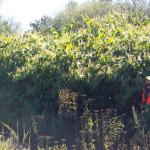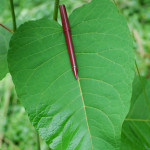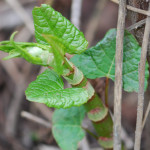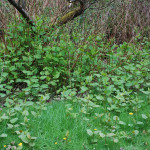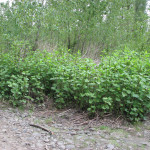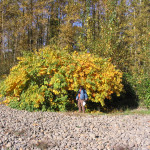Gallery:
- Knotweed infestation
- Large giant knotweed leaf
- Knotweed emerging stem and leaves
- knotweed emerging in Spring
- young knotweed stems
- Knotweed infestation
- Left – Japanese, Middle – Bohemian, Right – Giant
Common names:
Japanese knotweed (Japanese bamboo, sally rhubarb, fleeceflower, and Himalayan fleece vine, Mexican bamboo, false bamboo)
Giant knotweed (sacacline, sakhalin knotweed)
Bohemian knotweed (Japanese-Giant hybrid)
Scientific Name:
Japanese knotweed: Fallopia japonica (syns. Reynoutria japonica, Polygonum cuspidatum)
Giant knotweed: Fallopia sachalinensis (syns. Reynoutria sachalinensis , Polygonum sachalinensis)
Bohemian knotweed: Fallopia ×bohemica (syns. Reynoutria x bohemica, Polygonum x bohemicum)
Description:
Japanese, giant, and their hybrid Bohemian knotweed are all closely-related rhizomatous, semi-woody shrubs with hollow stems and showy flowers. Dense colonies of these highly invasive plants form due to their vigorous growth and ability to reproduce vegetatively through rhizomes and stems. Large infestations are extremely difficult to eradicate. Knotweed species can reach more than 12 feet in height and have more than 40 stems per plant. Erect stems are often arched at the top of the plants and are grooved, thick, and swollen at the nodes. Stems are green to reddish-brown. Knotweed is an escaped ornamental which thrives in disturbed, moist soils. It spreads easily through waterways which can carry root and stem fragments.
Life cycle:
Height of mature plants
15 feet
Flower color:
White
Bloom time:
July through October
Look-a-likes:
These three species can be differentiated by close examination of their leaves. Japanese knotweed has alternate, leathery, thick, oval-shaped leaves that are sharply tipped and square across the base. The leaves have few hairs, are 4-5 inches long on the stalks, and are sometimes reddish. Giant knotweed has alternate, leathery, lanceolate shaped leaves (pointed at both ends) with a heart-shaped base. These leaves are 12 inches across and 18 inches long on stalks, but can reach up to 2.5 feet long. There are few hairs on the underside veins and on the margins. Bohemian knotweed leaves have characteristics of both Japanese and Giant. They are bluntly tipped and usually have a square base.
Habitat:
Knotweed thrives in disturbed and moist soils. All species can be found in riparian and wetland areas, along roadsides, coastal forests, pastures, and open, upland areas with plenty of sunlight and moisture.
Impacts:
Knotweed forms dense thickets, shading out native plants and excluding native animals. It out-compete nearby vegetation for soil nutrients and light. Additionally, it decreases property values from the potential of asphalt, concrete, or foundation damage from the rhizome and the long-term investment in the management of the plants. Lastly, it can induce bank erosion and lower water quality.
Noxious Weed Listing:
- WeedWise: Maintenance
- State of Oregon: Class B
- State of Washington: Class C
- Four County CWMA: Class B
Origin:
eastern Asia
Links:
Japanese Knotweed Oregon Noxious Weed Profile
Giant Knotweed Oregon Noxious Weed Profile
Bohemian Knotweed – CABI Invasive Species Compendium
Japanese Knotweed – CABI Invasive Species Compendium

